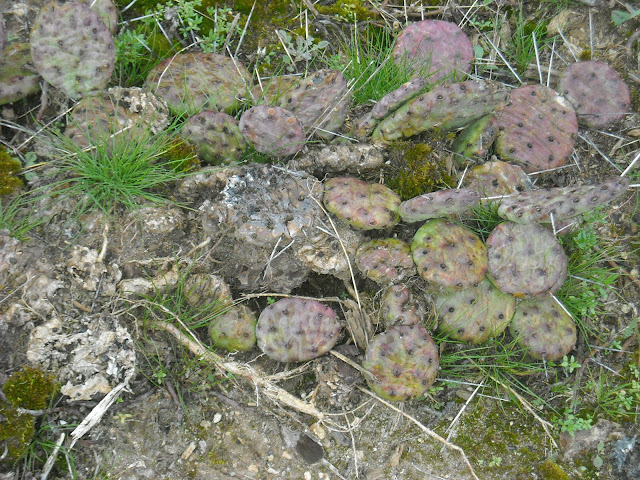 |
| Truck hauling chicken manure north on U.S. Highway 27, Carroll County (trust me, it was chicken poop) |
On a drizzly February morning, this roadside in southern Carroll County doesn't look special. The six-inch-high stubble tells me the D.O.T. mowed this shoulder in early fall; the privet and wild blackberry brambles haven't had time to break dormancy.
But the D.O.T. mows roadsides all over the state. So what?
 |
| Huge clumps of daffodils at abandoned home site, U.S. 27 North |
 |
| Looks as if they've been here a long time. |
Ask a silly question, get a silly answer! There were probably a hundred just on this little site, probably more. (I would've attempted a count, but was on my way to a meeting.)
As I post these pictures, it's early March, and these daffodils are just winding down three weeks of riotous bloom. They're the early type, meaning they appear at the very start of spring. Fortunately, we still have six weeks of daffodils to come; the mid- and late-season varieties will start up very soon.
Longtime gardeners can look at a leaf, a bloom, or a bark pattern and tell you exactly what kind of plant it is. Before you can even get the question out of your mouth—"What kind of pla..."—they're telling you the common name, the Latin name, its native habitat, and whether it grows around your area.
One day, I'll be able to do this with daffodils. Right now, I know only a few popular varieties, such as Erlicheer and Pheasant's Eye. For all others, I turn to Google Crapshoot.
 |
| Narcissus odorus campernelle, ADS Division 13. Thank you very much. |
Brent & Becky's Bulbs answered my question. These are Narcissus odorus camparnelle, classified in Division 13 by the American Daffodil Society. Brent & Becky's site states that this is "a terrific perennializer found in many old Southern gardens." B&B also say that they refer to these Division 13 daffs as "species daffodils, and most of which are Heirloom and suitable for restoration gardening." Good to know.
But I'm not sure these look exactly like Narcissus odorus campernelle. Those in my previous posts certainly do. Guess I'll have to send these photos to Brent & Becky, and ask whether they can identify this variety.
 |
| Love how they stand out against the winter-brown grasses. |
 |
| The flowers are about 2" wide, at most. |
So where was the house? I'm having trouble figuring it out. The tell-tale signs—a few large foundation stones, pieces of broken dishes, nails and horseshoes rusted to bits but still poking up from red mud—are nowhere to be found.
 |
| Front yard? Who knows? |
This is all I see looking south down U.S. 27. Maybe I'm wrong (and Lord knows it wouldn't be the first time), but this looks like it might have been someone's front yard 40 years ago.
Behind these daffodils, all I could see were dead trees and scary-looking old weathered roots and branches. Oh, and cacti. They're certainly not native to Georgia. Like the ubiquitous yucca, they're impossible to get rid of once you plant them.
 |
| Who in their right mind would plant this around the house? |
 |
| Dead pines and cedars poke out from between rocks |
 |
| What was here? What was way back there? |
So yes, people planted the daffs. People planted the nopales. Understood. But what might once have stood at the back of this site? Check out the serious rocks in the foreground of the last photo above! Hard to build a vernacular-style house on solid granite. Why the scary-looking dead pines and cedars? If there had been an infestation of pine beetles here, none of these pine trees would be alive. Hmm.
But about the planting:
U.S. 27 has been expanded by two lanes and rerouted in the last decade. Pretty flowers don't have to be in the front yard.
 |
| Beautiful no matter where they're planted. |
These were in the back yard. The house must have stood where the road now runs.
No comments:
Post a Comment